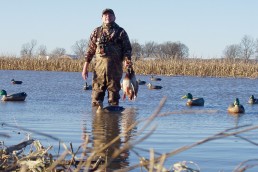Plenty of Ducks, but Expect Tough Hunting
SHARE THIS POST
Jerry Pabst warns that the abundance of mature ducks this season may make for a more challenging year for hunters.
Dry weather last spring has created an unusual circumstance for waterfowl hunters to deal with this fall. While the fall flight will contain a plentiful amount of ducks, hunters will need to rely on all of their skill to harvest many of them.
Delta Waterfowl forecasts that poor breeding conditions in the prairie pothole region will result in a smaller fall flight than waterfowl hunters have experienced for many seasons. But, the overall duck population is well above the long-term average.
The bad news is that in North Dakota, one of the few states able to carry out their annual breeding survey in a pandemic year, the breeding duck estimate dropped a hefty 26.9 percent. It was the highest percentage decrease in the history of the North Dakota survey. Due to Covid-related problems, the breeding survey was not carried out on the Canadian prairies for the second year, but by all indications, the lack of wetlands extended across this entire region, too.
Still, there are silver linings to be found when small, shallow prairie wetlands—those most vital to making ducks—dry out. Little precipitation fell throughout the winter and early spring, and in turn, the normally wet pools produced abundant vegetation. Dr. Frank Rohwer, president and chief scientist of Delta Waterfowl noted, “A lot of the prairies were dry, but the drought cycle rejuvenates wetlands with food for hens and ducklings in the following spring,” Assuming we have better water next year, ducks will rebound quickly. We could have outstanding duck production.”
Dr. Rohwer added, “There will be far fewer juveniles in the fall flight, and that’s unfortunate because the best seasons are always those when you’ve got an abundance of young ducks winging south.”
Despite indicating a significant decrease from 2020, North Dakota’s breeding-duck estimate remains 19 percent above the long-term average. And long-term data indicates that most duck populations are well above average—including a 2019 estimate of 38.9 million breeding ducks, 10 percent above average.
Not all the duck species suffered equally during the nesting season. Here is how some of them fared under the drought conditions.
Delta expects that mallards had poor production, mainly due to poor renesting conditions of failed nests.
Blue-winged teal, Delta believes, had a decent production year relative to other ducks. For ducks that rarely re-nest following nest destruction, drought has less of an impact.
Green wing teal nest farther north in the upper tier of the Canadian parklands and the boreal forest, where wetland conditions fluctuate far less year to year. Delta forecasts that their production was stable.
Are you enjoying this post?
You can be among the first to get the latest info on where to go, what to use and how to use it!
The gadwall population continues to boom, increasing 47.4 percent to 649,216 ducks—an incredible 109.5 percent above the long-term average. Rohwer said. “I suspect they did better than mallards because they’re less dependent on renesting.
The news is especially unfavorable for pintails, as conditions were very poor in prairie Saskatchewan—the traditional heart of the pintail’s breeding range—and the shallow wetlands that pintails especially depend on were nowhere to be found.
Delta believes that wigeon, which also have the core of their breeding range in Saskatchewan, did not fare well either in that exceptionally dry part of the prairies.
A decreased fall flight of canvasbacks is predicted as well, due to poor nesting conditions in the parklands of Saskatchewan, Manitoba, and indirectly, the Dakotas.
Redheads have been steadily increasing for years, but Delta believes this year’s conditions will result in a short-term reversal of that trend.
Production of bluebills was likely consistent with recent years this spring.
Ring-necked ducks are expected to have furthered their upward-trending population this spring. Unlike their close relatives, bluebills, ringers nest over water, where they appear to be more successful at hatching nests.
So, there you have it; during the current waterfowl season, you are going to be dealing with mainly smart, older birds that have been up and down the flyway several times, have seen all the hunters’ tricks, and heard all their different calling techniques. They are not going to be easy.
The only advice I can give you is, make sure every square inch of your blind is well covered, keep your face down and your duck call in your pocket, and let ‘em work.
For more tips on how to bring home your limit this hunting season, check out the fall issues of MidWest Outdoors, available by subscribing on our website.
Did you enjoy this post?
You can be among the first to get the latest info on where to go, what to use and how to use it!
Jerry Pabst
Jerry Pabst has been writing about the outdoors for over 40 years. He captained a Lake Michigan charter boat for 25 years and was inducted into the Fresh Water Fishing Hall of Fame. He has hunted waterfowl in all North American flyways, pursued upland game extensively, and trains his own dogs.

